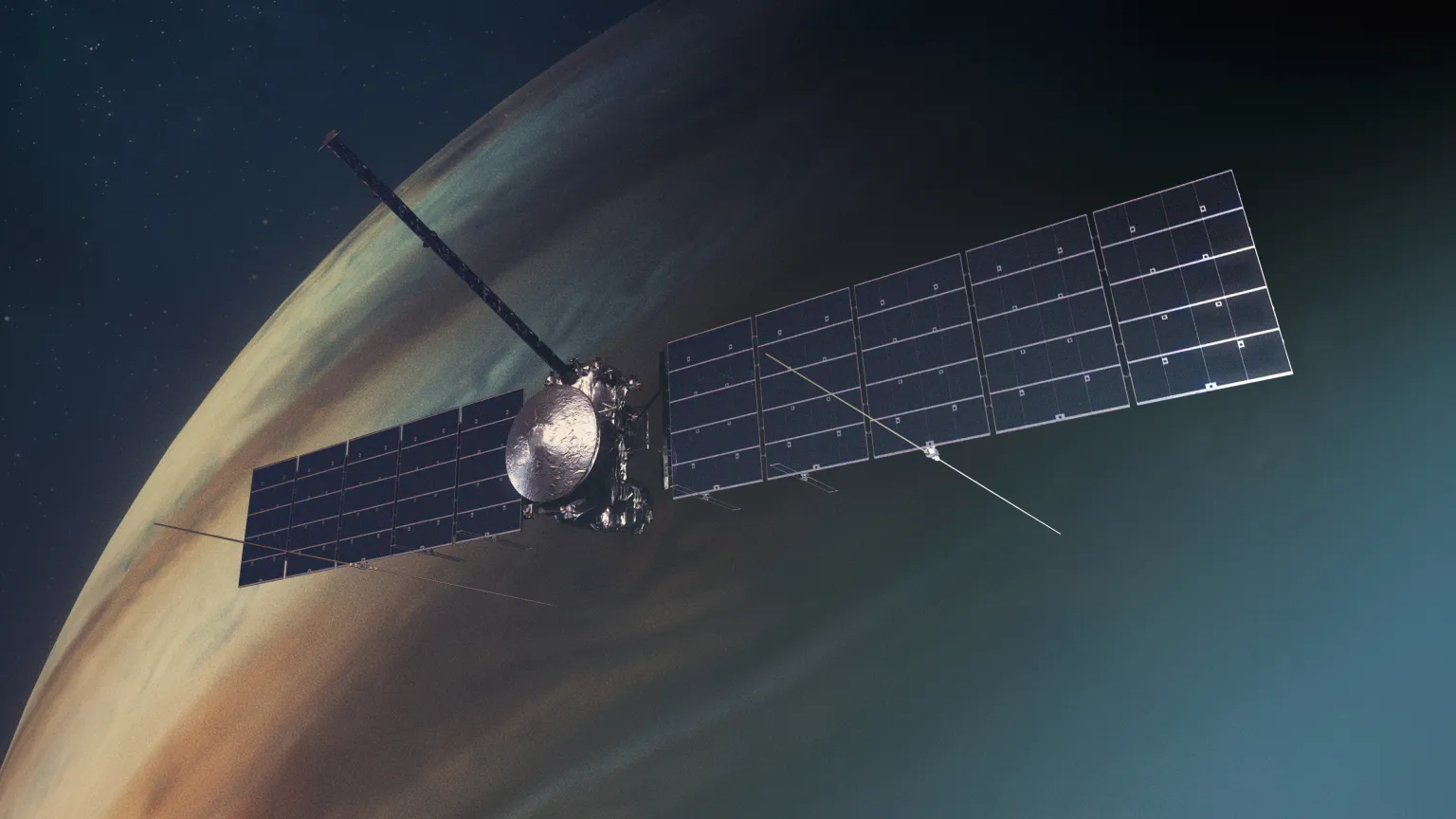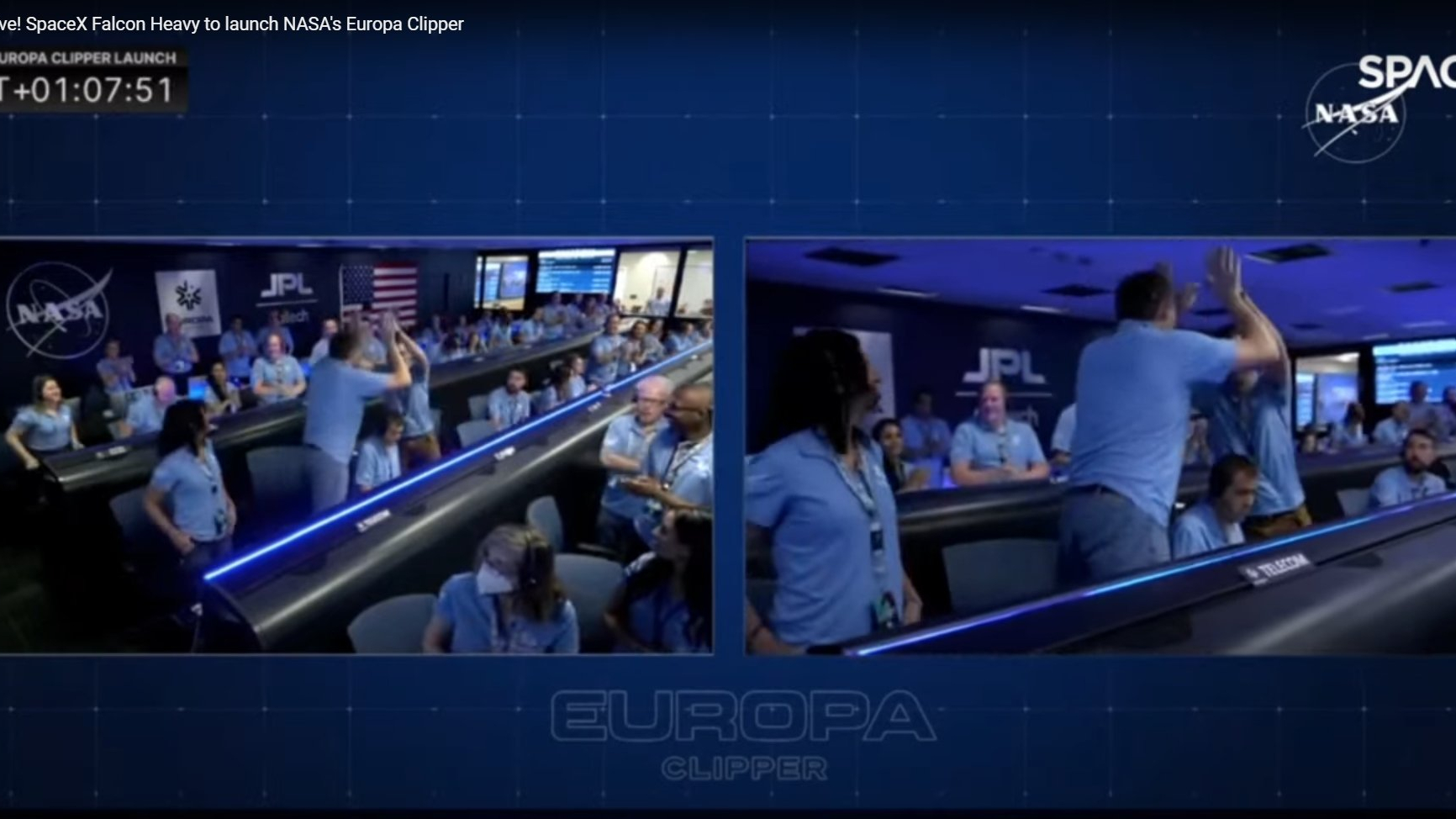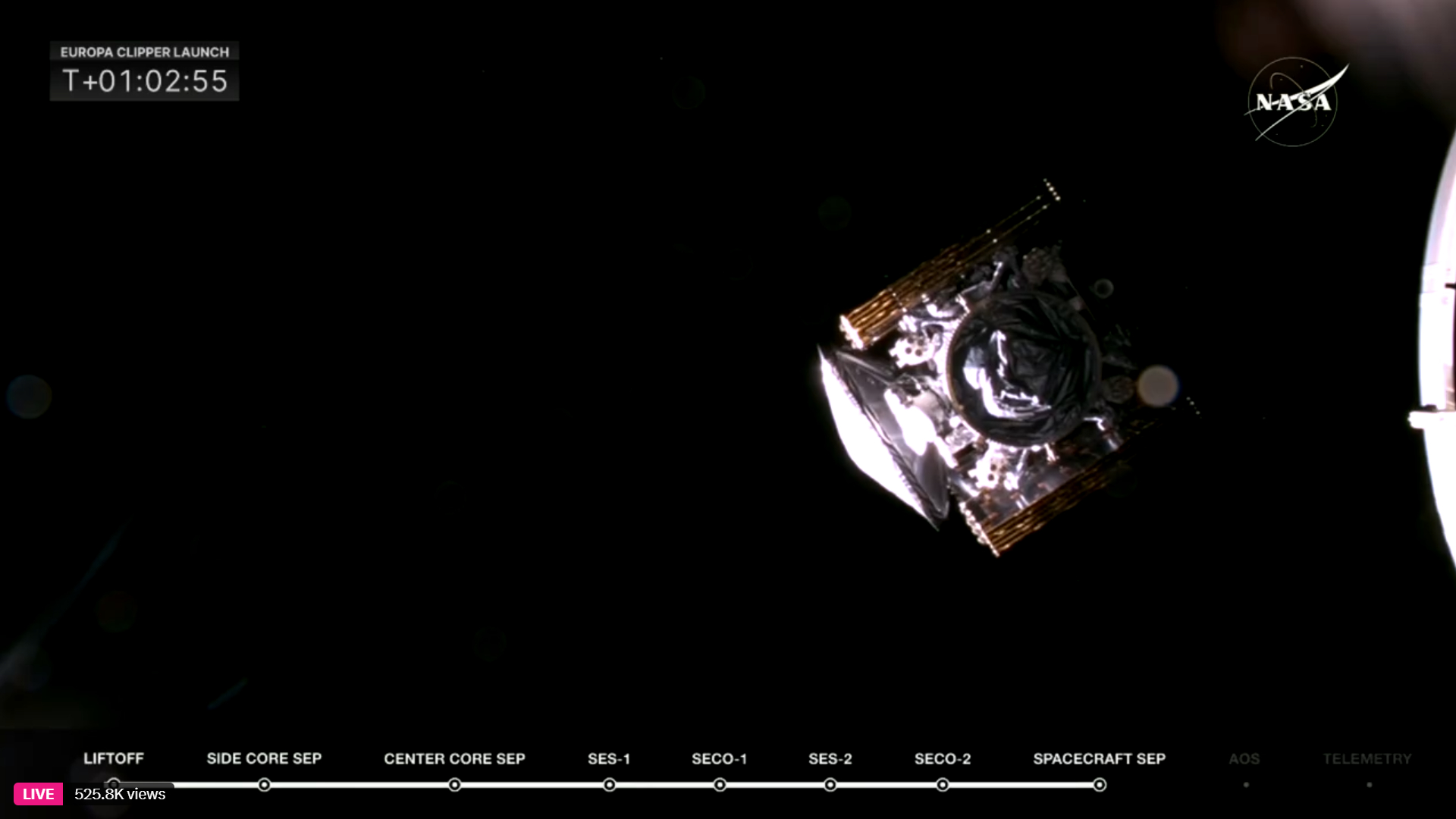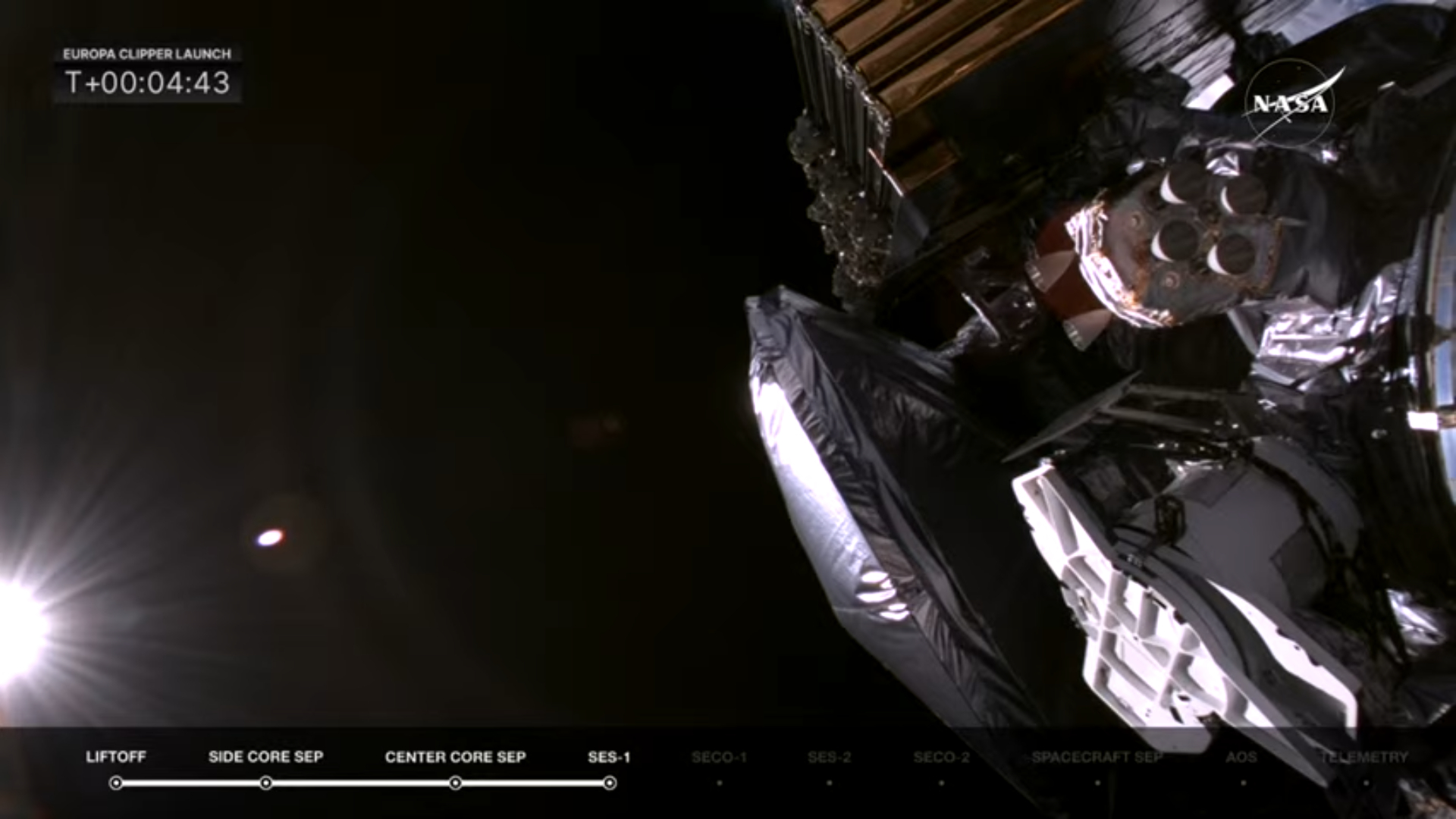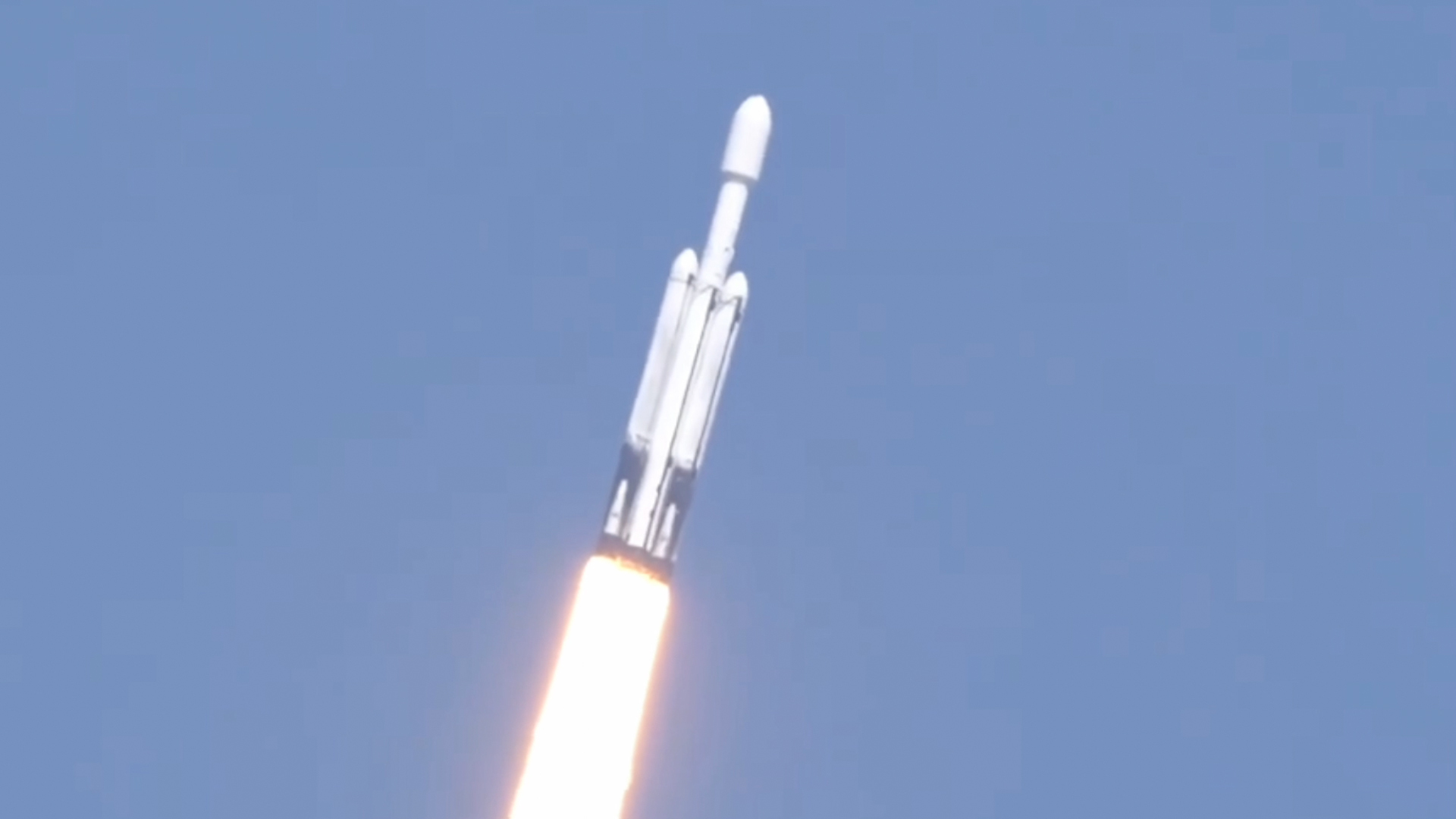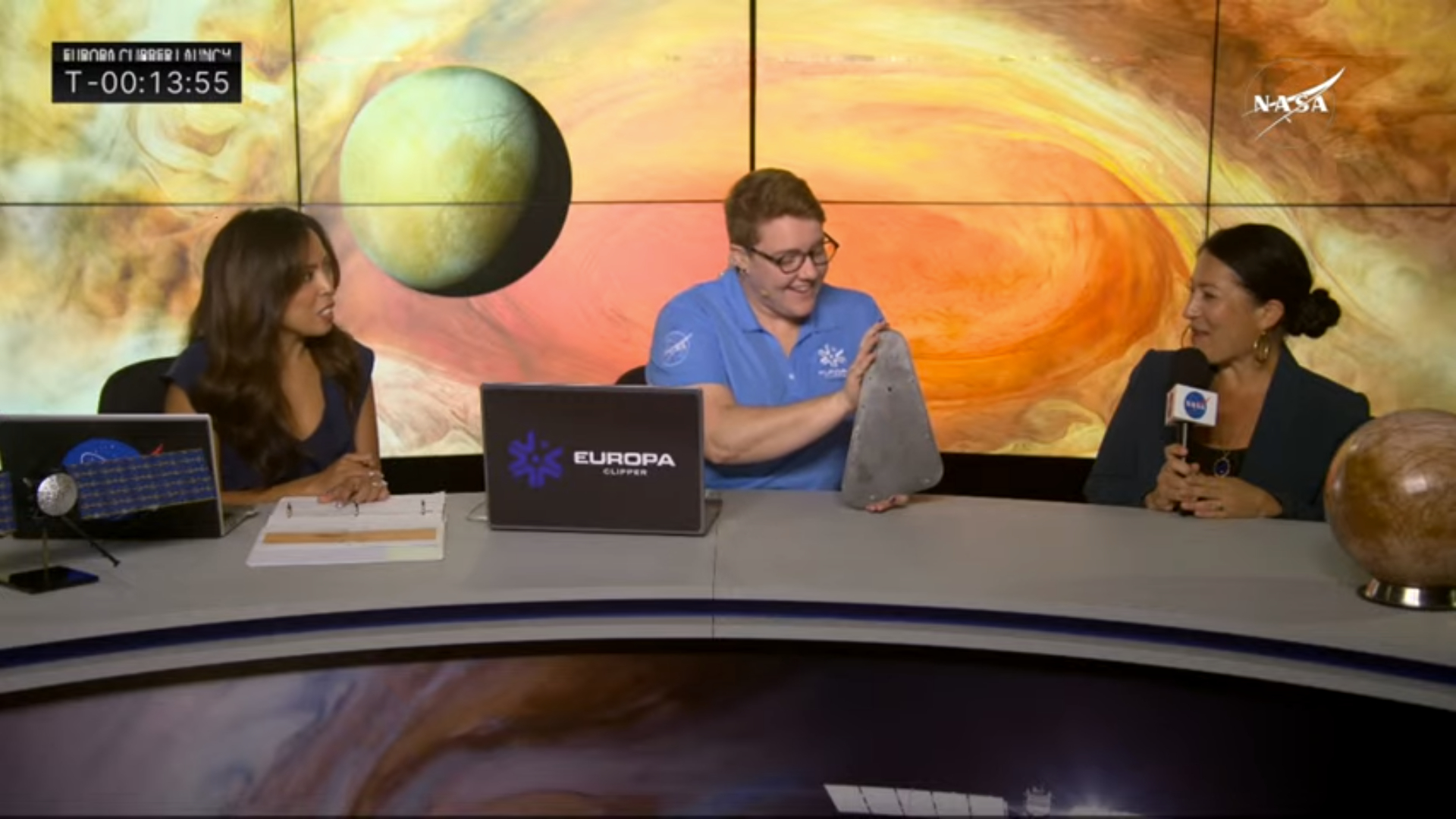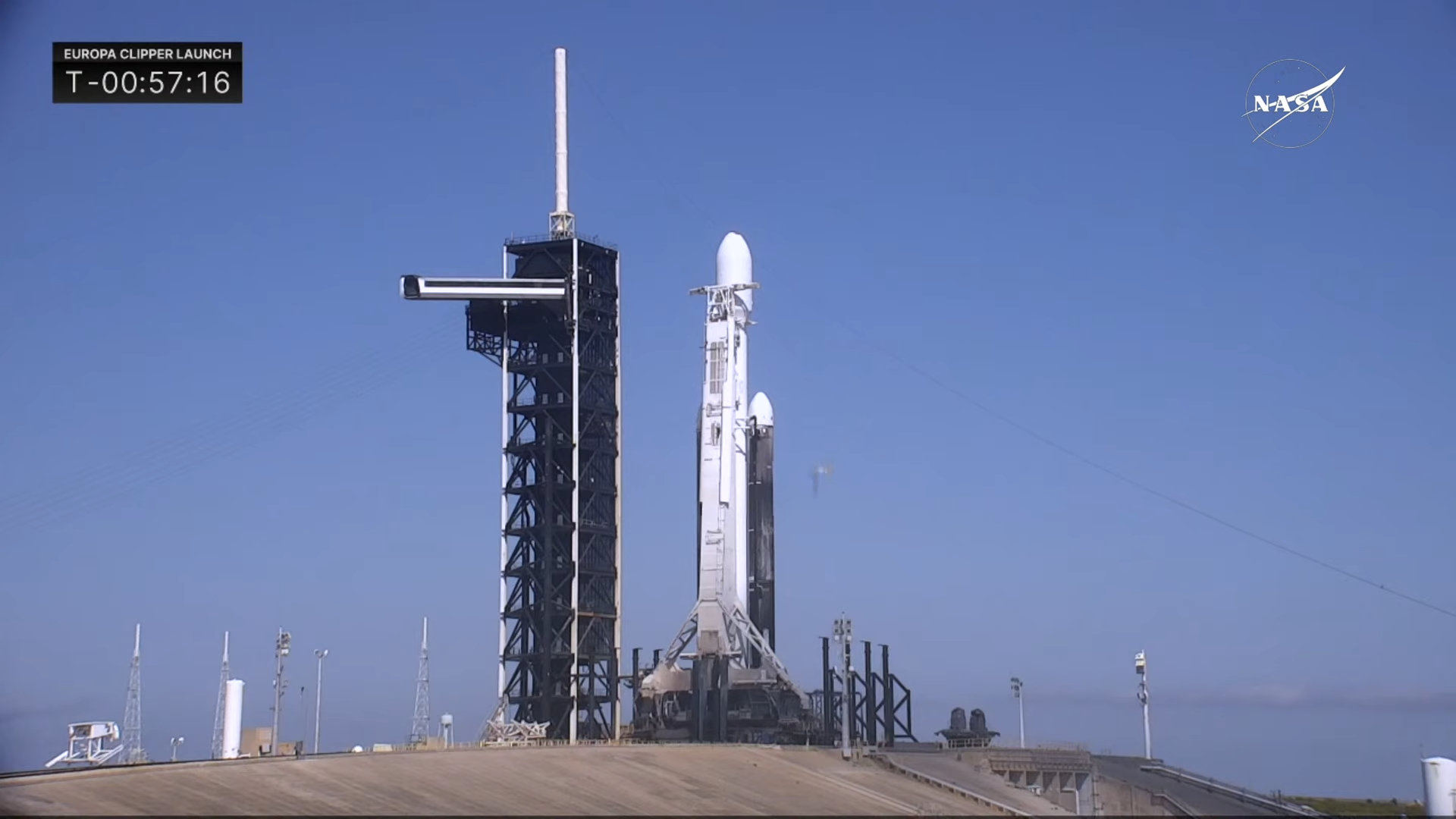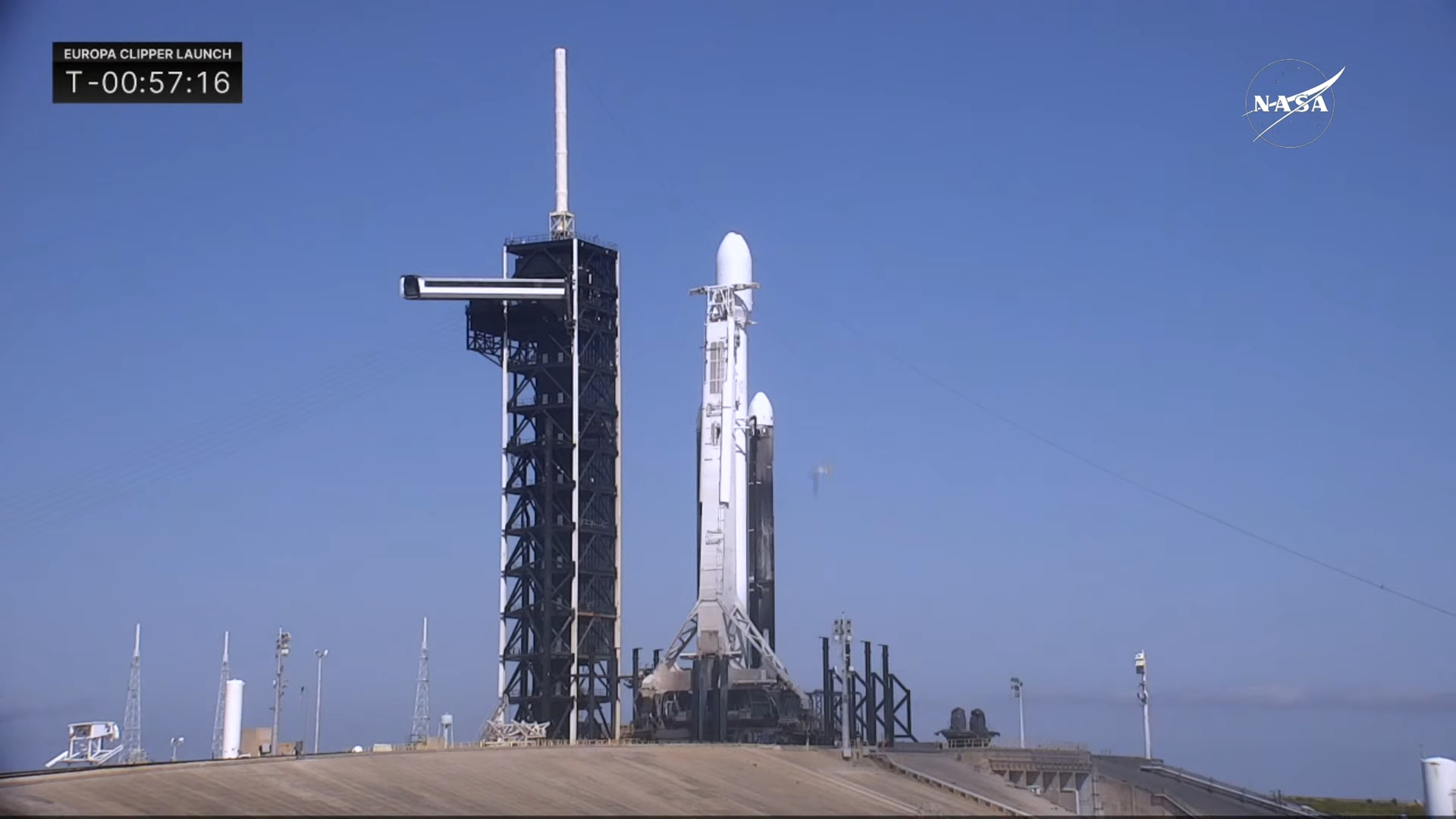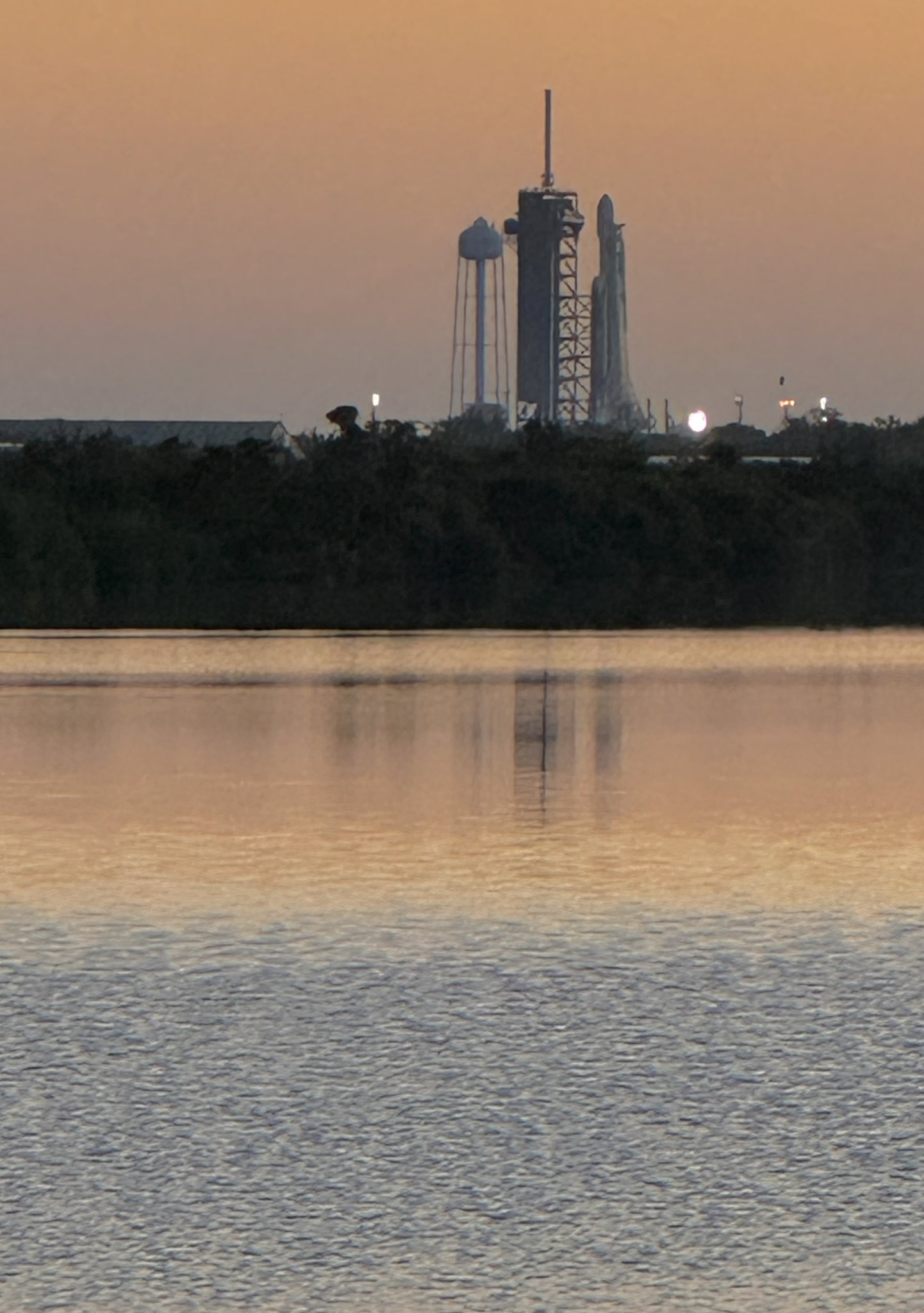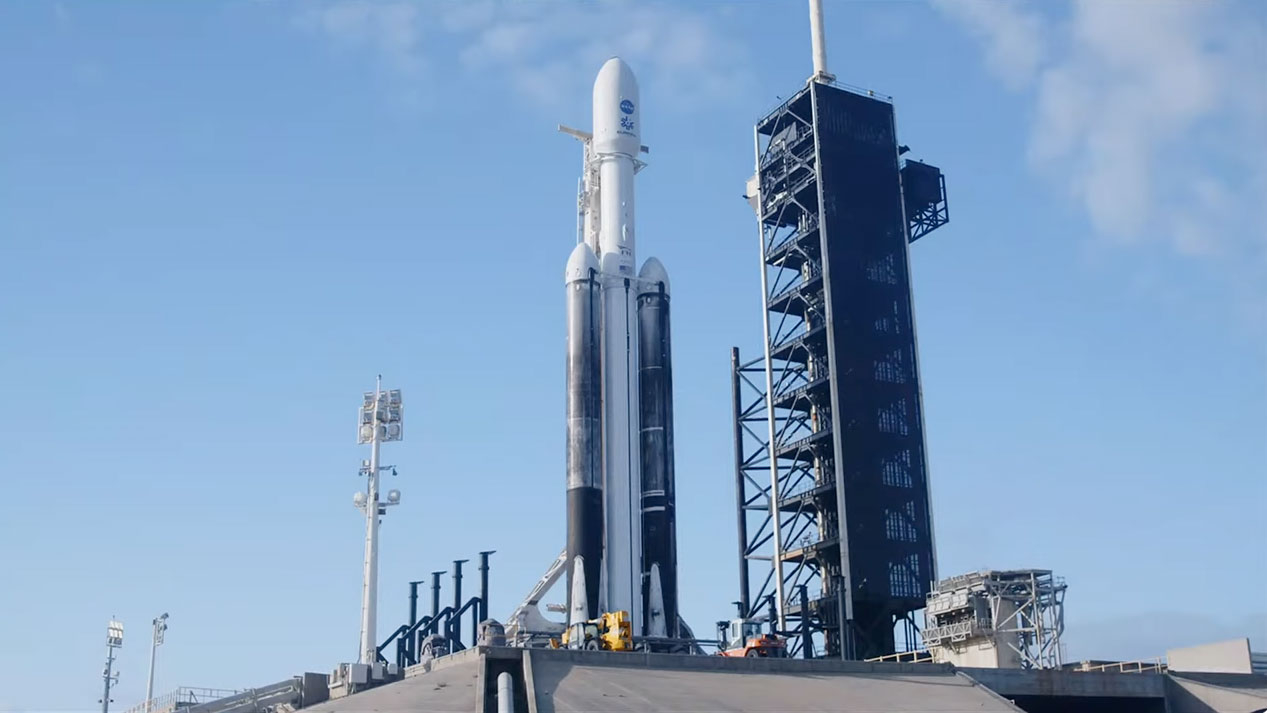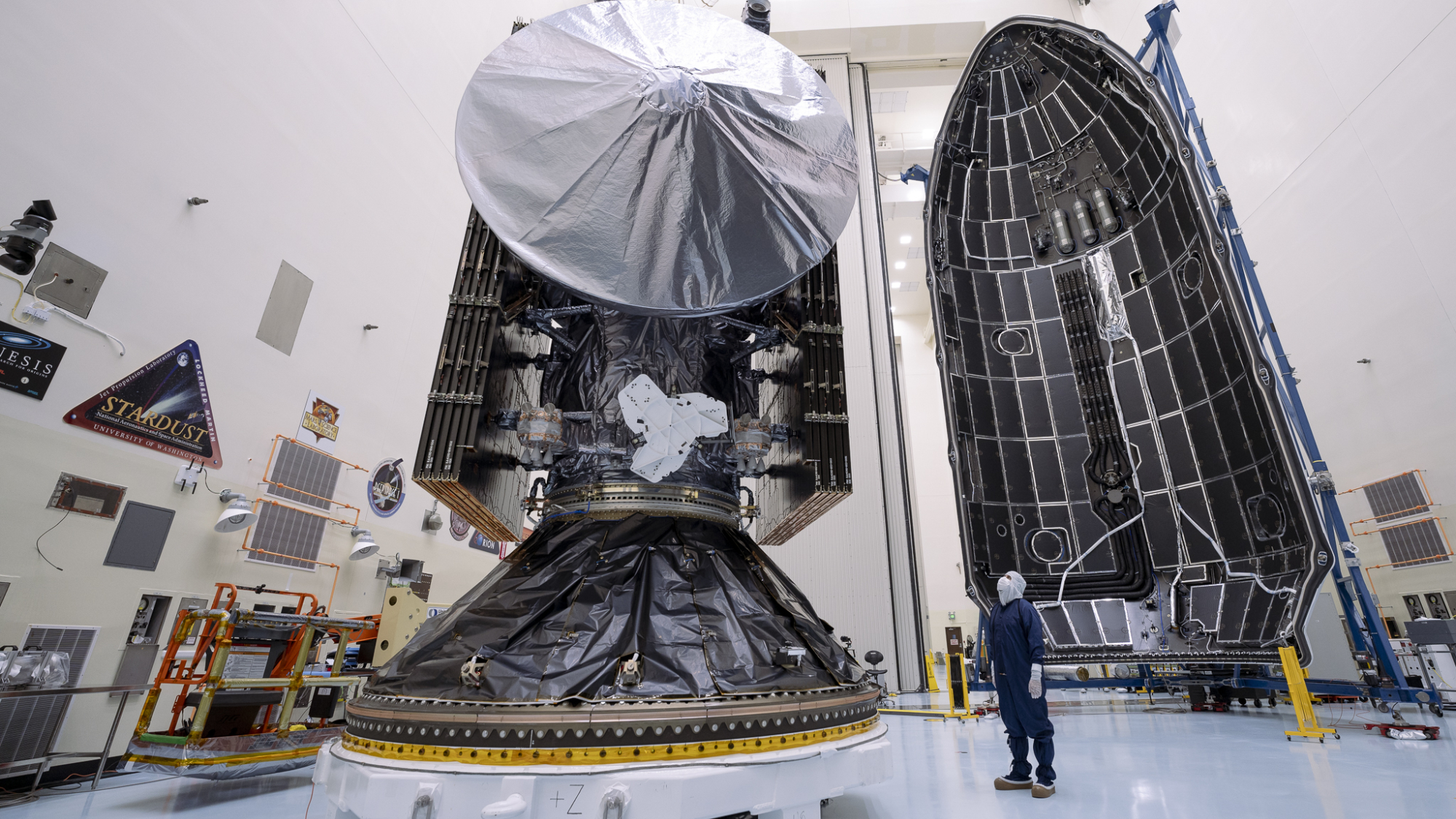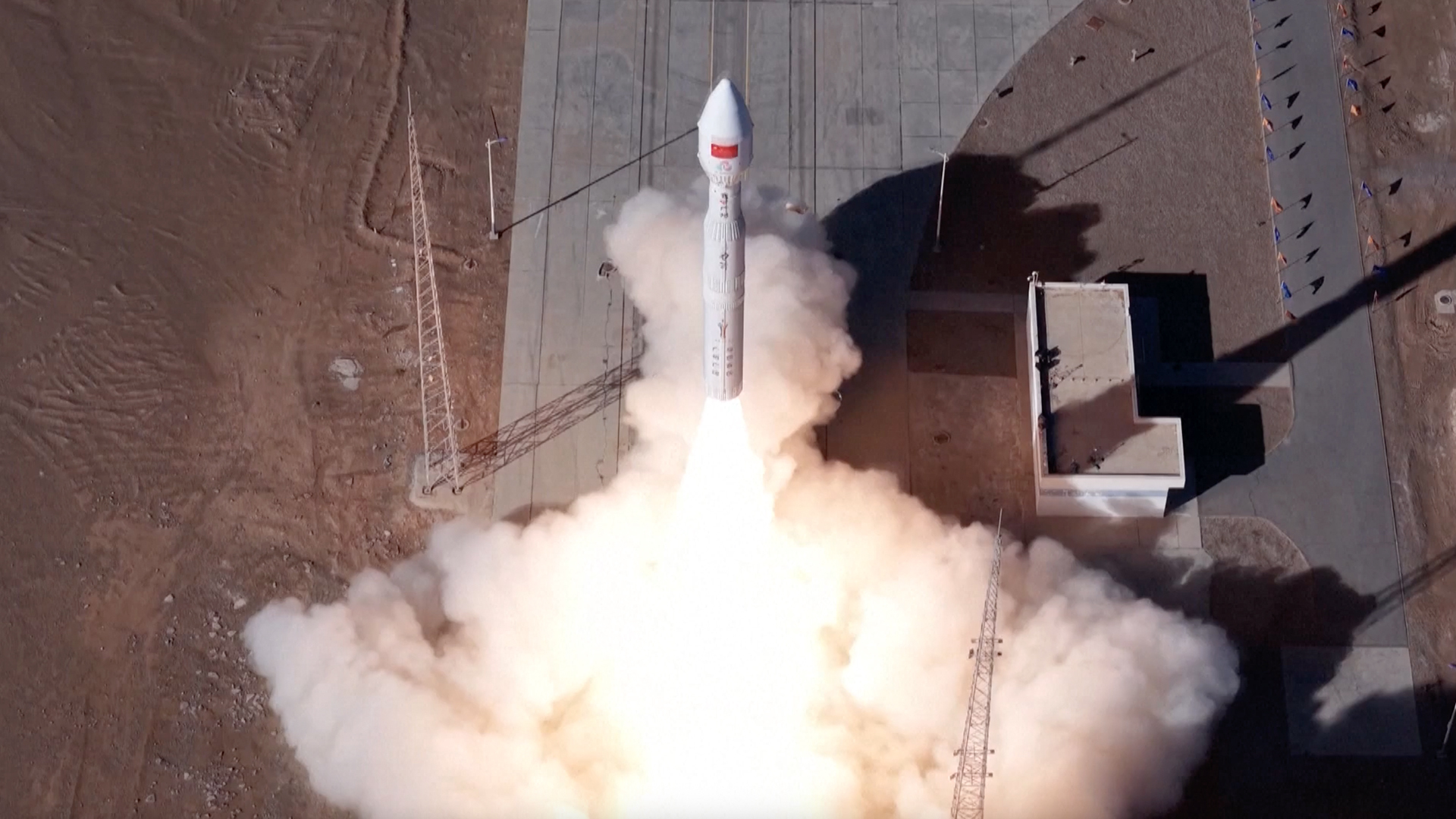NASA's Europa Clipper mission to Jupiter: Mission updates
See the latest updates for the launch of NASA's Europa Clipper to Jupiter's icy moon here.
- Europa Clipper "GO" for launch
- Launch Day for Europa Clipper
- NASA Europa Clipper livestream live
- SpaceX 'GO' for fueling for Europa Clipper launch
- SpaceX fueling Falcon Heavy for Europa Clipper launch
- Falcon Heavy 2nd stage fueling begins
- SpaceX loads liquid oxygen on Falcon Heavy
- Poetry flying to Jupiter on Europa Clipper
- Europa Clipper on internal power
- SpaceX eyes temperature on Falcon Heavy
- LIFTOFF of Europa Clipper
- Stage separation for Falcon Heavy
- Europa Clipper reaches parking orbit
- Europa Clipper in good health in orbit
- SpaceX Falcon Heavy 2nd stage fires engine
- Spacecraft separation! Europa Clipper flying on its own
- Europa Clipper signal acquired
- Europa Clipper begins voyage to Jupiter
- Clipper is now power-positive
NASA's flagship Europa Clipper spacecraft will explore Jupiter's icy moon Europa on a mission to understand how habitable Jovian satellite, with its vast salty ocean wrapped in a thick ice crust, really is.
A SpaceX Falcon Heavy rocket will launch the $5 billion Europa Clipper toward Jupiter from NASA's Kennedy Space Center Pad 39A near Cape Canaveral, Florida on Oct. 14, 2024. Liftoff is set for 12:06 p.m. EDT (1606 GMT). Read on for the latest updates on the launch and flight to Jupiter.
Launch livestream | Europa Clipper | Search for life | Falcon Heavy
Europa Clipper deploys solar arrays
Europa Clipper has deployed both of its solar arrays, meaning it now has a reliable source of power for the long trip to Jupiter.
"The process began with the cutting of hold-downs keeping the solar arrays folded against the sides of the spacecraft and then the unfolding of one 'wing' at a time," NASA officials wrote in an update this afternoon (Oct. 14). "With each wing measuring 46.5 feet (14 meters) long, Europa Clipper’s solar arrays are the biggest NASA has ever developed for a planetary mission."
Europa Clipper begins voyage to Jupiter
NASA's Europa Clipper spacecraft has begun its 1.8 billion-mile trek to Jupiter and appears to be working well after today's successful launch on a SpaceX Falcon Heavy rocket. Read our full Europa Clipper launch wrap story.
Flight controllers at NASA's Jet Propulsion Laboratory operations center did report an apparent venting issue with the probe's propulsion system, but later added that the system was still performing as expected.
The next major milestone will be spacecraft solar array deployment, which is scheduled to occur about six hours after launch.
That will be a wrap for Space.com's launch coverage for Europa Clipper today. Thank you for joining us. We'll post mission updates as they are warranted, including for solar array deploy, on this page as we chronicle Europa Clipper's mission to Jupiter and its icy moon Europa.
Above you'll see a video of Europa Clipper's deployment. Here's a launch replay below.
Europa Clipper signal acquired
Europa Clipper flight controllers at NASA's operations center at the Jet Propulsion Laboratory report a successful signal acquisition after spacecraft separation. They have steady telemetry and are reviewing the spacecraft's systems.
Flight controllers reported an apparently vent failure on the spacecraft, which the team is looking into, but did say Europa Clipper's propulsion system does appear to still be working as planned.
Spacecraft separation! Europa Clipper flying on its own
The Europa Clipper has successfully separated from its SpaceX Falcon Heavy upper stage, with NASA's flight control team awaiting signal acquisition from the spacecraft.
The spacecraft is currently warming up two radios on board to phone home, NASA says.
SpaceX Falcon Heavy 2nd stage fires engine
The second stage of SpaceX's Falcon Heavy rocket has fired its engine for one last burn to send Europa Clipper on its final path toward Jupiter.
The burn lasted just over three minutes and is the final major milestone before spacecraft separation.
"Nominal orbit insertion," SpaceX reports.
Europa Clipper in good health in orbit
SpaceX and NASA are receiving good telemetry from the Falcon Heavy rocket and Europa Clipper as they continue to coast in orbit, as everything continues to proceed as planned after today's successful liftoff.
Europa Clipper has passed the mid-point of its coast phase ahead of today's deployment at 1:08 p.m. EDT (1708 GMT).
Europa Clipper reaches parking orbit
SpaceX's Falcon Heavy rocket has successfully reached a parking orbit with NASA's Europa Clipper spacecraft after a smooth launch into space.
The Falcon Heavy second stage will coast for about 40 minutes, at which time it will fire its engine once more for about 3 minutes to send Europa Clipper on a trajectory beyond Earth.
Spacecraft deployment is scheduled for 1 hour and 2 minutes after liftoff, at about 1:08 p.m. EDT (1708 GMT).
Stage separation for Falcon Heavy
The twin side boosters on SpaceX's Falcon Heavy has separated from the core stage, followed shortly after by the first stage.
SpaceX is not reusing the boosters for this flight. The two side boosters were previously used to launch NASA's Psyche asteroid mission.
The Falcon Heavy's clamshell like payload fairings have also separated as planned. SpaceX will try to recover those fairings after launch.
Europa Clipper is now exposed to space for the first time.
LIFTOFF of Europa Clipper
LIFTOFF! NASA's Europa Clipper launches toward Jupiter atop SpaceX Falcon Heavy rocket!
SpaceX eyes temperature on Falcon Heavy
SpaceX's strongback support device for today's Falcon Heavy launch has retracted for launch with just minutes remaining for launch at 12:06 pm ET (1606 GMT).
SpaceX is monitoring temperatures on the 2nd stage of the Falcon Heavy. NASA and SpaceX are go for launch, pending a resolution of the temperature concerns.
Europa Clipper on internal power
SpaceX and NASA are now less than 10 minutes away from the planned launch of Europa Clipper on a Falcon Heavy rocket at 12:06 p.m. EDT (1606 GMT).
Europa Clipper is now on internal power for launch, SpaceX reports.
SpaceX is using all of the fuel on today's Falcon Heavy for launch. There will be no attempted landing of the first stage boosters, since their max performance will be needed to send Europa Clipper on its trajectory to Jupiter.
Poetry flying to Jupiter on Europa Clipper
NASA's Europa Clipper is not just carrying science experiments and instruments to Jupiter with today's launch.
Also riding aboard are millions of names of people who signed up to be added on a chip for the flight, as well as "A Poem for Europa" written by U.S. Poet Laureate Ada Limón. The poem is for everyone, she says.
"You know, I really hope that as we embark on this incredible voyage together, that we are reminded of the wonders all around us," Limón said.
SpaceX loads liquid oxygen on Falcon Heavy
SpaceX is now loading the liquid oxygen on the upper stage for Falcon Heavy's Europa Clipper launch. The fueling process will continue until the final minutes before launch. Launch remains on track for launch at 12:06 pm ET.
Falcon Heavy 2nd stage fueling begins
SpaceX has begun fueling the upper stage of its Falcon Heavy rocket with the RP-1 propellant for today's Europa Clipper launch.
All systems remain "go" for today's planned 12:06 p.m. EDT (1606 GMT) launch.
SpaceX fueling Falcon Heavy for Europa Clipper launch
SpaceX has begun fueling its Falcon Heavy rocket's first core stage and side boosters with the RP-1 propellant (a rocket-grade kerosene) and liquid oxygen needed for today's launch.
With the liquid oxygen loading underway, if SpaceX has to delay today's launch for any reason, the next opportunity will now be 48 hours later on Wednesday due to the time needed gather more liquid oxygen, NASA says. NASA and SpaceX have until Nov. 6 to launch Europa Clipper to Jupiter.
SpaceX 'GO' for fueling for Europa Clipper launch
NASA launch director Tim Dunn has polled the NASA and SpaceX Falcon Heavy launch teams for today's Europa Clipper launch to ensure the rocket is ready for fueling. All systems, it seems, are go.
"We've got beautiful weather, a beautiful spacecraft and a great rocket," Dunn said as he started the poll as he checked with flight controllers, all of whom were "go" for launch. "The NASA Europa Clipper team is go for propellant load and go for launch."
Today's Europa Clipper launch is on track for 12:06 p.m. EDT (1606 GMT). There is a 95% chance of good weather at launch time, NASA has said.
NASA Europa Clipper livestream live
NASA's Europa Clipper launch livestream is underway as SpaceX and NASA near the T-1 hour mark for today's planned 12:06 p.m. EDT (1606 GMT) launch.
You can watch the launch live in the window above and on Space.com, but also directly from NASA and the its YouTube page.
"We think Europa's been simmering away for the last 4 billion years, so it's a great places to look to see if it's been habitable," NASA's Europa Clipper science systems engineer Jenny Kampmeir said as the webcast began.
Launch Day for Europa Clipper
It is launch day for NASA's Europa Clipper spacecraft!
The $5 billion probe is on track to launch toward Jupiter today, Oct. 14, at 12:06 p.m. EDT (1606 GMT) from NASA's Pad 39A at the Kennedy Space Center. A SpaceX Falcon Heavy rocket, with its triple-booster first stage, is providing the ride.
You'll be able to watch the Europa Clipper launch live online starting at 11 a.m. EDT (1500 GMT), but if you can't wait that long to get your Europa fix on, we've got you covered.
From "2010: The Year We Make Contact" to the 'Europa Report," don't miss our list of 4 must-see Jupiter movies to prepare for Europa Clipper by writer Jeff Spry. You may disagree with some of the choices, but I can assure you they're all fun film rides. (Especially "Europa Report," that one is awesome!).
Europa Clipper "GO" for launch
NASA and SpaceX are both "GO" to launch the Europa Clipper spacecraft toward Jupiter's moon Europa on Monday, Oct. 14, 2024 after days of delays caused by the impacts of Hurricane Milton on its Florida launch site.
Europa Clipper, a $5 billion flagship mission to an icy moon of Jupiter, is currently scheduled to lift off at 12:06 p.m. EDT (1606 GMT) from NASA's Kennedy Space Center in Florida during a tiny 15-second launch window. There is a 95% chance of good weather at launch time, Space Force officials said. Read our full guide on when and how to watch Europa Clipper launch.
NASA originally hoped to launch Europa Clipper on Oct. 10, but decided along with SpaceX - which will launch the probe on a Falcon Heavy rocket - to push back the launch last week as Hurricane Milton approached. On Saturday (Oct. 12), the space center reopened for business and the Falcon Heavy carrying the probe returned to the launch pad by Sunday.
Europa Clipper is designed to reach the Jupiter system in April 2030 and spend four years making close flybys of Europa, one of the most promising places in our solar system for the search for life beyond Earth. Europe's dominant feature is its vast salty ocean contained under a thick ice crust, which sometimes escapes through vast water plumes.
NASA scientists will use Europa Clipper's instruments to better understand how habitable Europa may be.
In this space, we'll include the latest launch and mission updates on Europa Clipper during its long voyage to Jupiter. Check back on Oct. 14 for live launch coverage!
